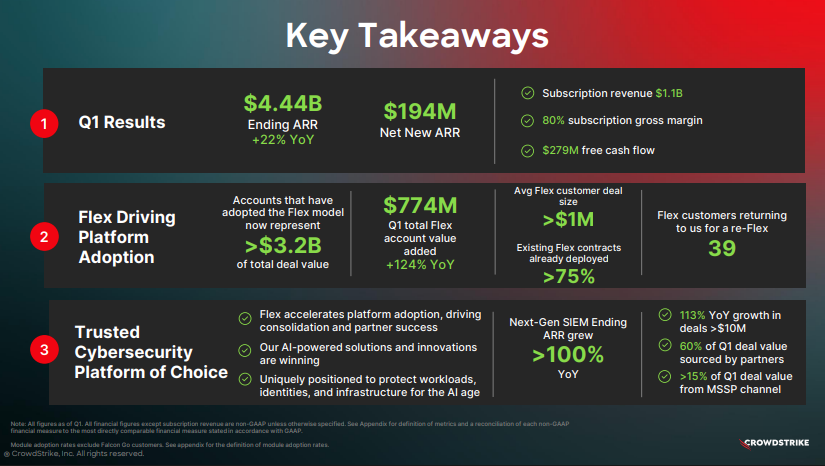CrowdStrike delivered mixed first quarter results and second quarter outlook.
The company reported a first quarter net loss of $110.2 million, or 44 cents a share, on revenue of $1.1 billion, up 20% from a year ago. Non-GAAP earnings were 73 cents a share.
Wall Street was expecting CrowdStrike to report non-GAAP earnings of 66 cents a share on revenue of $1.11 billion.

As for the outlook, CrowdStrike projected second quarter revenue of $1.14 billion to $1.512 billion. Wall Street was looking for $1.16 billion in revenue for the second quarter. Non-GAAP earnings for the second quarter will be 82 cents a share to 84 cents a share. For fiscal 2026, CrowdStrike projected $4.74 billion to $4.8 billion with non-GAAP earnings of $3.44 a share to $3.56 a share.

The company said it authorized up to $1 billion to buy back shares, which are now up more than 58% from a year ago.
Despite the results that disappointed Wall Street, CrowdStrike delivered a strong quarter. CEO George Kurtz said the company started the fiscal year with a large deal and saw strong net retention. "The scale of Falcon Flex demand and the pace of innovation across AI, next-gen SIEM, cloud, identity, and exposure management advances us towards $10 billion in ending ARR," said Kurtz.
CFO Burt Podbere said CrowdStrike was seeing customers consolidate on Falcon Flex and the company had a strong pipeline for the second half of fiscal 2026.
Kurtz said the following on the earnings conference call:
- "In less than 2 years since starting Falcon Flex, we've closed more than $3.2 billion of total account deal value across more than 820 accounts that have adopted the subscription model."
- "A lot of what we're doing with customers is going through the demand plan and our business value assessment, and that's really where we can talk about how we can replace other point products. So typically, the conversation will look at customer road map. They'll look at certainly our road map and the products we have in the 30 modules. And then we'll begin to plan the phased rollout of our products to replace what they have."
- "When we think about generative AI and really, what I'd call autonomous agents, they have the same needs, but they're superhuman. They have access to data. They have identities. They have access to systems outside of their own environment. They have workflows. They take action. So it's building those guardrails and then instrumenting the visibility and protection across the entire AI workflow. And every agent, and there could be billions of agents, are going to need protection."


